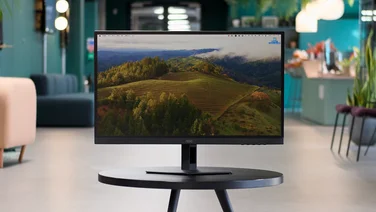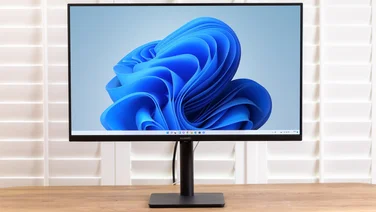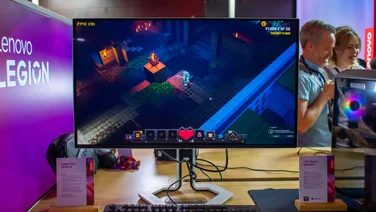To help us provide you with free impartial advice, we may earn a commission if you buy through links on our site. Learn more
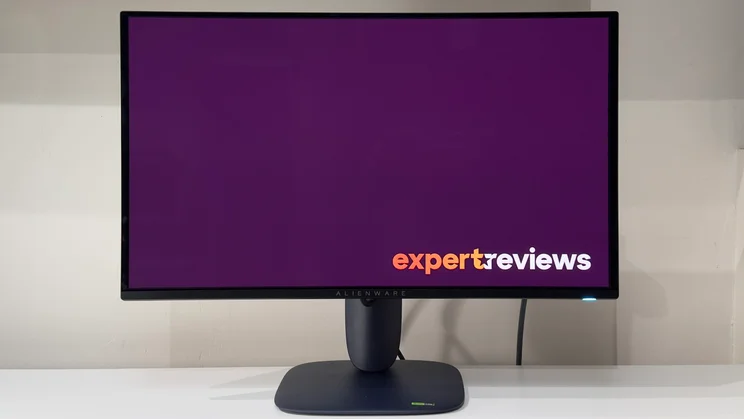
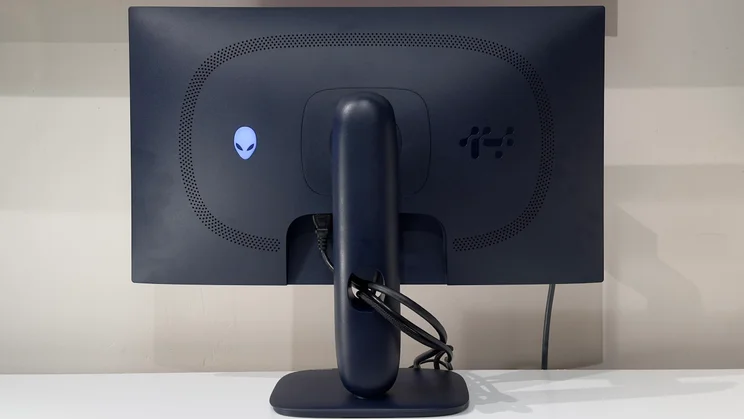
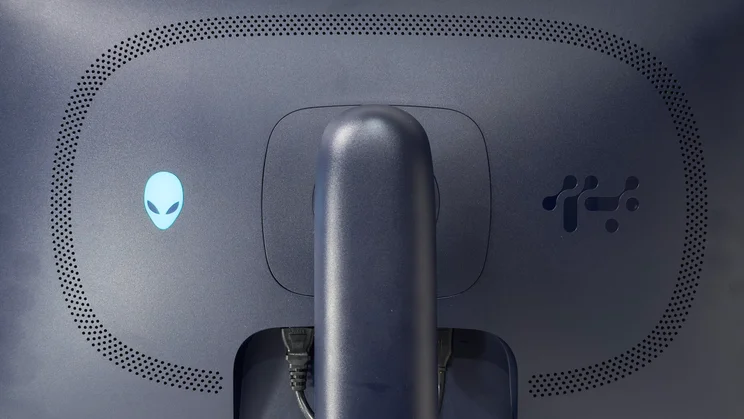
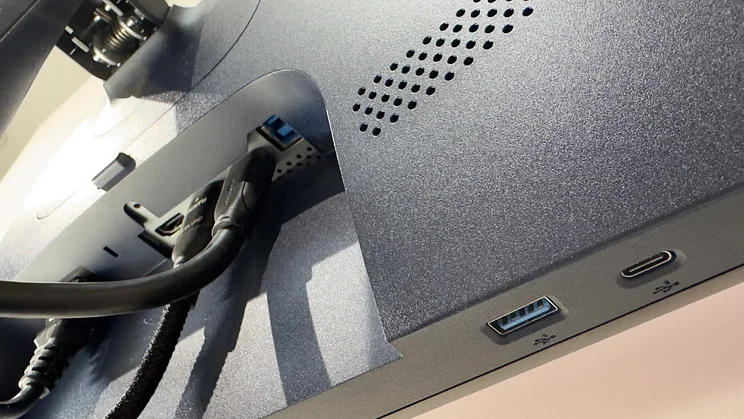
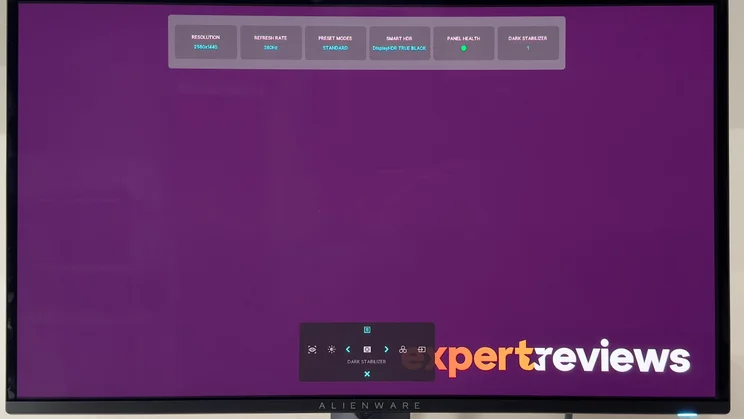
- Crisp, blur-free 280Hz gaming
- Great colour accuracy
- Ample brightness for SDR and HDR
- Text clarity is poor
- No USB-C input
- Black level suffers in bright rooms
The Alienware AW2725D looks like the perfect recipe for a sub-£500 gaming monitor. The main ingredient is a 280Hz 2,560 x 1,440 QD-OLED panel with a nippy 0.03ms GtG response time and peak brightness of over 1,000cd/m2. Naturally, this is served on a bed of gaming-friendly features such as a crosshair overlay and preset picture modes for different game types.
And yes, most importantly of all, it has an RGB-backlit alien skull. There are less exciting extras, such as a fully adjustable stand and a built-in USB hub, though, if practicality is higher up your priority list than extra terrestrial style points.
Alienware AW2725D monitor: What do you get for the money?
The AW2725D is a more affordable version of Alienware’s AW2725Q. Instead of the 4K 240Hz fourth-generation QD-OLED panel on the AW2725Q, the AW2725D uses a third-generation 2,560 x 1,440 280Hz panel. That last-gen panel sees the price tumble from around £700 to a more appealing sub-£500, and it also makes a more realistic proposition for people with less than top-end GPUs. Make no bones about it, hitting 280fps in modern games requires quite a bit of GPU power – and some willingness to settle for less than maximal detail settings.
Visually, the AW2725D is a love it or hate it design. If you don’t like the little alien skull aesthetic of Alienware’s products, then you’re not going to appreciate the finer points of the AW2725D. From the front, it’s actually very subtle and tasteful, with a deep midnight blue base and shell, a subtle logo along the slender lower bezel and an edge-to-edge design around the top three sides framing the super glossy 27in panel. Build quality is rather plasticky and hollow, though; the AW2725D doesn’t feel anywhere near as solid as the similarly priced Dell UltraSharp U2725QE, for example.
Peer around the back and you can admire the RGB backlit alien skull and alien hieroglyphic imprint. You can choose to have the logo backlit with 19 different colours, and the same goes for the little power button on the monitor’s bottom right-hand edge. Set it to Aurora mode, and both rapidly cycle through all the available colours. Alternatively, you can turn them both off, or only have the power button illuminate when the monitor is in standby.
The adjustable stand is serviceable. You get 110mm of height adjustment, 90 degrees of pivot in both directions, 20 degrees of swivel in either direction and 26 degrees of forward and backward tilt. The height mechanism is a tad stiff – two-handed adjustments make life easier – but that stiffness does keep the monitor nice and stable, even when you’re frantically bashing the keyboard mid-game. A large oval cut-out in the stand guides cables neatly out of sight, too.





Connectivity includes one DisplayPort 1.4 input and two HDMI 2.1 inputs. Picture-in-picture and picture-by-picture is supported, too, which is nice to have. One thing there isn’t, however, is a downstream USB-C with DisplayPort Alt and power delivery. Instead, you get one USB-B input and this feeds the single USB-A port and USB-C port under the monitor’s front edge with data and 15W of power delivery.
The Alienware AW2725D’s on-screen display is similar to Dell’s recent monitor family, but there are a few changes and additions here and there. One major difference is that the four-way joystick has been moved from its usual position on the right-hand lower rear of the monitor to just underneath the central Alienware logo on the lower bezel.
This makes a lot of sense. This is a monitor that encourages you to adjust the various settings and in-built features to suit the game at hand and it’s allied with the customisability we’ve come to expect from other recent Dell monitors. You can set each directional movement to access a specific setting, which is super handy, and you can also select which features are listed in the quick menu. Take a little time to get everything just so, and it’s possible to have every adjustment you need just a couple of taps away.
One gaming-specific addition is the HUD (head-up display), which appears at the top of the screen when you open the menu. This gives an at-a-glance overview of the current resolution, refresh rate, picture mode, HDR mode and dark stabiliser setting. There’s also a little traffic-light coded coloured indicator for OLED panel health. A green dot tells you all is fine, whereas a yellow dot indicates a pixel refresh cycle is required, and this is automatically carried out every four hours of use when the monitor is turned off or goes into sleep mode.
How good is the image quality?
The first time you connect the AW2725D, you may wonder if something is wrong. Compared to the standard 27-inch WQHD IPS monitor on my desktop, the AW2725D’s QD-OLED panel looks like it’s running at the wrong resolution as text is so fuzzy. This, sadly, is just a by-product of the pixel structure of the QD-OLED panel – that’s just how it looks.
A word to the wise: if you need a monitor for productivity as well as gaming, then you’d be well advised to save up for a 4K QD-OLED panel. The higher pixel density on 4K QD-OLEDs means the pixel structure has less of an impact on text clarity – or you can opt for a VA or IPS-based gaming monitor instead.
It’s only once you leave the Windows desktop that the AW2725D’s WD-OLED panel delivers the kind of performance IPS and VA-panelled rivals can only dream about. The SDR peak brightness of 250cd/m2 isn’t particularly high, but this goes hand in hand with a claimed HDR peak brightness of 1,000cd/m2 and a 1,500,000:1 contrast ratio. The range of colour that QD-OLED can produce is unrivalled, too, and Dell claims 99.3% coverage of the DCI P3 colour space.





In my testing, the AW2725D delivered the goods. It covered 99.5% of DCI-P3 and an impressive 93.8% of Adobe RGB, and colour accuracy was spot on. The default Standard picture mode is essentially a Display P3 profile. It covers the DCI-P3 colour space but has an sRGB-like gamma curve and aims for a 6,500k white point. In my tests, it was pretty darned accurate, too. The average Delta E is a low 1.15 and the white point is only slightly warmer than the 6,500k ideal at 6,263k.
It is also possible to lock the monitor to an sRGB colour space in the Creator mode, and this was similarly accurate. The average Delta E of 1.29 is very good and again the white point was just a touch too warm at 6,287k.
If colour accuracy is less crucial to you, then you can select one of the game-specific presets. There are modes for FPS, MOBA/RTS, RPG and Sports, and each of these adjust the image in the hope of providing a competitive edge; for instance, by raising the shadow detail to make it easier to see enemies lurking in dingy corners. There are also three Game profiles you can customise for specific titles by manually adjusting RGB Gain and Offset, RGBCMY Hue and Saturation and the Dark Stabiliser setting. It’s a shame you can’t manually select sRGB or Display P3 colour spaces for each, however.





The only obvious image quality issue is the AW2725D’s tendency to crush shadow detail a little too eagerly. In my time with the monitor, the black optimiser controls regularly came in handy for achieving a good balance between contrast and shadow detail on a game by game basis.
Peak brightness is limited, which is something you’d expect of an OLED monitor like this. With the brightness control set to its default 75 out of 100, I recorded a peak white of 183cd/m2. Push it to maximum, and you’ll hit 269cd/m2, which is good going for a QD-OLED panel if unimpressive by LCD monitor standards. Switch to HDR and smaller highlights reach 458cd/m2 in the default HDR mode. Engage the HDR Peak 1000 mode, however, and those same highlights rise to 1,014cd/m2.
These figures translate into a near-perfect gaming monitor. Fast-paced games such as Doom Eternal come to life and really benefit from the triple-figure refresh rates. The HDR presentation looks stunning, with intensely bright highlights, a sumptuously vivid palette of demonic gore and the kind of motion clarity which turns frantic gunplay into an almost serene experience. Subjectively, the AW2725D delivers on every count: with framerates locked well up above the 200fps mark, there’s not a hint of blur or fuzz, and everything just looks crystal clear.
One common issue with OLED (and VA) gaming monitors, is VRR flicker. This is a phenomenon where rapidly changing framerates – for instance, sudden drops from triple figures down into double figures – can cause a highly distracting onscreen flickering effect. In practice, the AW2725D does exhibit this. I used a simple VRR flicker test built by MattTS01 on Github, in addition to real-world testing, with adaptive sync enabled on an AMD Radeon 9070XT.





In the VRR flicker test, which rapidly shifts the framerate up and down, the shimmering effect is obvious once VRR is enabled and it’s most pronounced in the darker greys. In games, however, I didn’t notice it very often, and never to a hugely distracting extent.
And in any case, the issue goes away if framerates remain stable. It’s possible to run the AW2725D at 60Hz, 75Hz, 100Hz, 120Hz, 240Hz and 280Hz refresh rates, so you can pick the best match for the framerates your GPU can sustain, and use a framerate limiter to prevent fps spikes. With a bit of care, most users should be able to find a flicker-free combination that works for their hardware and preferred games.
One of the AW2725D’s final issues is one that applies to QD-OLED monitors in general – they struggle in brighter light. They’re normally brighter than their WOLED relatives, but the panel structure is simply more susceptible to ambient lighting. In brightly lit rooms, you’ll notice that black starts to look increasingly grey and the panel exhibits a purplish, reddish tinge. Turn down the lights – and avoid direct lighting completely – and all the shadow detail returns, but put the AW2725D – or any QD-OLED panel – side by side with a WOLED screen, such as the LG 45GX90SA I tested recently, and the difference is stark. WOLED panels are simply far better at producing good black levels in a wider range of lighting conditions.
A final moan is a practical one: the AW2725D’s glossy panel is a pain to keep clean. The edge-to-edge design looks great, but every time you move the display you’ll leave fingerprints all over the edges of the panel. These are unusually resistant to wiping away, too, so you’ll want to keep a clean microfibre cloth close to hand.
Should you buy the Alienware AW2725D monitor?
If you’re after a genuinely do-it-all display that can flit effortlessly between heart-stopping action and sedate productivity work, then the Alienware AW2725D is not it. The text clarity on WQHD OLED monitors leaves a lot to be desired and, frankly, I’m not sure I’d want to risk the possibility of burn-in from static menus and browser tabs. It’s essential to factor in the panel’s sensitivity to lighting, too.
While the AW2725D can’t fix QD-OLED’s shortcomings, though, it does do a great job of showcasing the technology’s strengths. The vivid colour palette, impressive accuracy and eye-popping HDR are impressive in their own right, and combine that with the blur-free 280Hz refresh rate and gaming-friendly adjustability, it’s hard not to come away impressed. With a price that’s well below £500, it’s fair to say Alienware has served up a slice of almost-affordable gaming delight.


